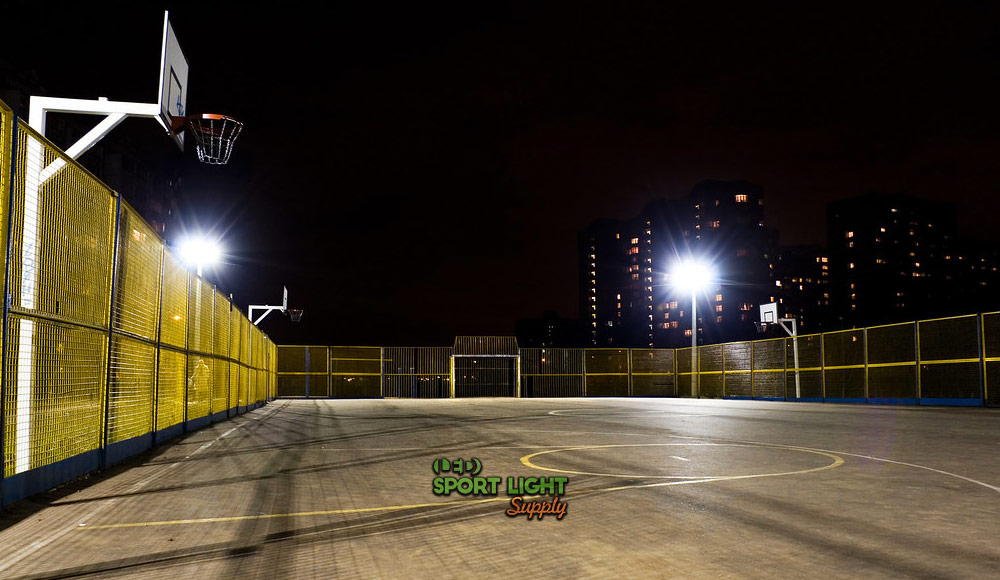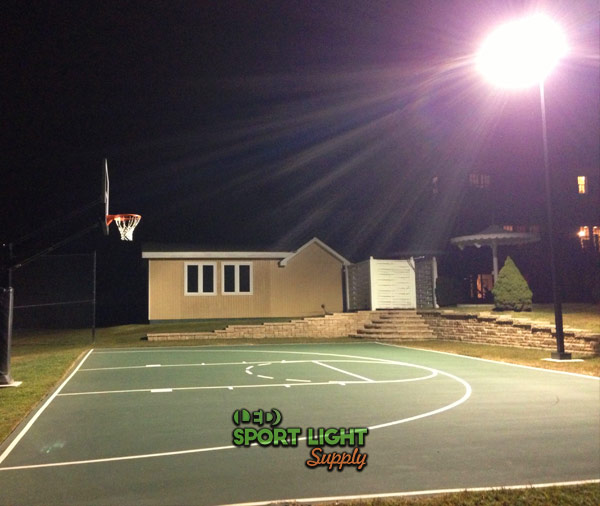Basketball court lighting is crucial for creating an optimal playing environment and ensuring broadcast-quality visuals. The height of light poles for basketball courts typically ranges between 10 and 35 feet, but selecting the ideal height requires careful consideration and a thorough photometric analysis. The number of poles needed and their height depend on the specific layout of the high mast lighting system. Each setup can vary, affecting both the distribution and intensity of light across the court.
Choosing the right pole height involves weighing several pros and cons. Poles that are too high may result in uneven lighting and potential glare issues, which can adversely impact players’ performance and the overall viewing experience. On the other hand, poles that are too short might not provide adequate coverage, leading to dark spots and insufficient illumination. These lighting conditions are particularly significant in outdoor basketball arenas where lighting quality directly influences gameplay and the visual appeal of the event for TV broadcasts.
In addition to the immediate effects on the court, pole height decisions also impact long-term considerations. Galvanized steel poles, commonly used for their durability, typically have a lifespan of 20 to 30 years. Therefore, investing in the right height and setup not only affects the current quality of light but also represents a significant long-term investment. A well-planned lighting system with properly chosen pole heights ensures optimal performance, enhances the playing environment, and offers a better return on investment over the poles’ lifespan.
Table of Contents
ToggleDangers of Excessively High Light Poles Near Basketball Courts

Average Light Pole Height for Basketball Courts
When it comes to basketball court lighting, the height of the light poles plays a crucial role in ensuring both safety and optimal illumination. Generally, a height of around 30 feet is more than sufficient to effectively light a standard basketball arena. Even in professional settings like NBA courts, which are typically no wider than 50 feet, this height provides adequate coverage. Installing excessively high poles without a valid reason is not recommended. If high mast lighting is not feasible on both sides of the court, consider alternative solutions such as spotlights or mobile light towers.
Maintenance and Safety Concerns
Opting for overly tall poles can lead to increased maintenance costs and safety hazards. Maintenance of high poles often requires specialized equipment, which not only raises expenses but also poses significant risks. The primary danger is the potential for falls during maintenance, which can be exacerbated by cramped working conditions. The height of the pole itself can create a hazardous environment, with the risk of tools or objects falling and potentially injuring spectators or players below.
Moreover, the logistics of rescuing a maintenance worker from a high pole require careful planning. Although professional maintenance companies are equipped to handle such situations, it’s essential to plan for sufficient space around the pole to accommodate necessary machinery or equipment. By considering these factors, you can enhance both the safety and effectiveness of your basketball court lighting setup.
Uniformity, Light Loss, and Energy Wastage in Basketball Court Lighting
Impact of Tall Light Poles on Uniformity
Tall light poles can significantly enhance lighting uniformity in a basketball stadium, ensuring that the entire playing surface is evenly illuminated. By positioning the lights higher above the court, the light spreads more uniformly, minimizing shadows and creating a better visual experience for both players and spectators. However, while height can improve light distribution, it also introduces challenges related to light loss and energy efficiency.
Challenges with Light Loss and Maintenance
As light fixtures age, their output diminishes due to light loss, a phenomenon where the brightness of the light decreases over time. Each light pole has its own characteristics related to light loss, which can be further exacerbated by environmental factors such as bad weather. This depreciation in light output makes regular maintenance essential. Routine cleaning of fixtures and timely replacement of light bulbs are critical to maintaining optimal lighting performance.
Even with LED lights, which are known for their longevity and cost-effectiveness, regular maintenance is necessary. LED fixtures, while more durable and efficient, are not immune to light loss caused by factors such as dirt accumulation on the luminaires. When fixtures become dirty, the light filtering through the lens is reduced, leading to diminished illumination and increased energy wastage.
To counteract light loss and maintain adequate lighting levels, you may need to install additional light sources. This not only increases initial costs but also results in higher ongoing maintenance requirements. Regular cleaning and upkeep of light fixtures are essential to prevent unnecessary energy wastage and ensure that the lighting system operates efficiently over its lifespan.

Glare Issues in Outdoor Basketball Court Lighting
Impact of Light Glare on Gameplay
Glare is a significant concern when it comes to outdoor basketball court lighting. When light sources are positioned too close to the ground, they can create excessive glare, which impairs players’ vision and affects their performance. During a game, players rely on visual acuity to execute tactical maneuvers, whether it’s the point guard navigating the ball down the court or the shooting guard making long-range shots and playing within the key.
Players frequently look around and up, making them particularly vulnerable to glare from improperly positioned lights. In an outdoor basketball stadium, if the light poles are too short and the lights are too bright, players can be blinded or distracted. This is especially problematic during critical moments, such as taking long shots or making quick passes. Even if the luminaires are directed downward, the intensity of the light can still cause discomfort and hinder the players’ ability to focus on their game.
Solutions and Considerations
To mitigate glare, you can use glare shields, which help to redirect and control the light output. However, using a glare shield on a short pole may lead to reduced illuminance and affect the overall lighting quality. Therefore, it is crucial to balance the height of the light poles with the angle and tilt of the luminaires to achieve optimal lighting conditions. The goal is to ensure that the lighting is sufficient for gameplay while minimizing glare and maintaining comfortable vision for the players.
Safety Concerns Related to Short Basketball Court Light Poles
Risks of Overheating and Safety Hazards
Short light poles pose several safety concerns, especially when traditional light bulbs are used. Conventional lighting options, such as Metal Halide (MH) bulbs, can reach temperatures exceeding 1500 degrees Fahrenheit, posing a significant risk of burns to players, referees, and spectators. The high temperatures of these bulbs increase the risk of heat-related injuries and accidents.
Moreover, High-Pressure Sodium (HPS) lamps and other gas-discharge lamps can become dangerously hot and may even explode under certain conditions. When these lamps overheat, they can release blazing fragments that can cause fires or inflict severe injuries if they fall onto individuals. These fragments can cut or blister skin, creating serious safety hazards.
Traditional light bulbs also emit ultraviolet (UV) rays, which can be harmful with prolonged exposure. UV light can damage the skin and eyes, making it important to minimize exposure by using safer lighting alternatives.
Benefits of Switching to LED Lighting
To address these concerns, switching to LED lights is highly recommended. LEDs operate at much lower temperatures than traditional bulbs, reducing the risk of burns and fire hazards. They also eliminate the issue of UV emissions, making them safer for both players and spectators. Furthermore, LED lights have a longer lifespan and do not require the long cool-down periods associated with MH and halogen bulbs. Traditional bulbs can take up to 15 minutes to cool down before they can be safely replaced, whereas LEDs offer immediate usability and reduce maintenance downtime.
If your basketball court lighting setup already includes many short poles, consider retrofitting them with LED lights. Opt for LEDs with equivalent or lower light output to match the required illuminance level. Additionally, using LED spotlights from a greater distance can help achieve optimal lighting while maintaining safety and efficiency.
Wiring and Structural Issues in Basketball Court Lighting
Structural Integrity of Light Poles
Whether you choose tall or short high mast poles, the quality and design of the structure play a critical role in ensuring safety and functionality. High mast poles are subjected to various stresses, including steady winds and site-specific conditions, which can lead to structural fatigue over time. If the design does not adequately address these factors, the pole may become unstable, resulting in issues such as snapping or excessive movement.
One common problem is harmonic motion or vibration, which can impact the weakest points of the pole, such as welded joints or cast ends. These vibrations, if not properly managed, can lead to the formation of cracks and eventually cause structural failure. Ensuring that the poles are designed to withstand local environmental conditions and properly constructed is essential to avoid such issues.
Impact of Underloading
Another important consideration is the risk associated with underloaded poles. An expert designer must take into account various factors when determining the appropriate height and strength of light poles, including the specific lighting standards for the basketball court and the overall size of the stadium. An underloaded pole, which is not adequately supported or anchored, may be more susceptible to failure under stress.
In addition to structural integrity, proper wiring and installation practices are crucial. Poor wiring can lead to electrical faults or failures, which can affect the performance of the lighting system and pose safety risks. Ensuring that both the structural and electrical components are designed and installed correctly helps maintain the safety and effectiveness of the lighting system.
Addressing these structural and wiring issues requires careful planning and expertise. By considering all relevant factors and employing high-quality materials and construction techniques, you can prevent potential problems and ensure the longevity and reliability of your basketball court lighting setup.
Conclusion
Ensuring the safety, efficiency, and effectiveness of basketball court lighting involves careful consideration of pole height, structural integrity, and proper maintenance. Whether opting for tall or short poles, it’s essential to address potential issues such as glare, overheating, and wiring concerns to create an optimal playing environment. By choosing high-quality materials, implementing regular maintenance routines, and adhering to expert design principles, you can enhance both the performance of the lighting system and the overall safety of the court, providing a better experience for players and spectators alike.
